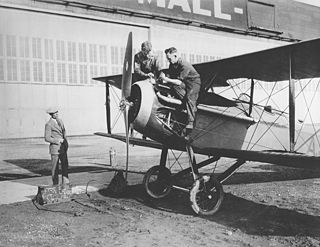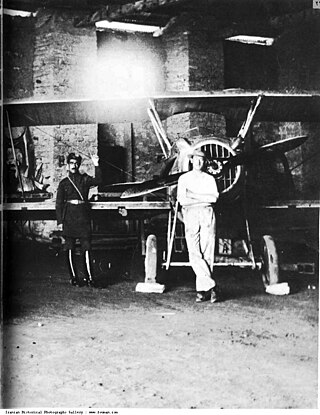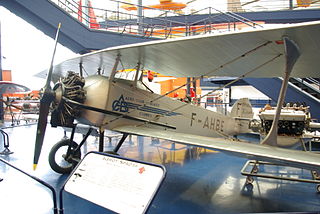Related Research Articles

The Stroukoff YC-134, designed in 1956, was based heavily on the Fairchild C-123 Provider, itself designed by Michael Stroukoff. The United States military contracted with Stroukoff Aircraft Corporation to develop an improved version of the aircraft, combining features that the company had developed for the YC-123D and YC-123E.

The Vought VE-7 "Bluebird" was an early biplane of the United States. First flying in 1917, it was designed as a two-seat trainer for the United States Army, then adopted by the United States Navy as its first fighter aircraft. In 1922, a VE-7 became the first airplane to take off from an American aircraft carrier.

The Blériot-SPAD S.34 was a French twin-seat, single-engine biplane flight training aircraft designed in 1920. The side-by-side seating arrangement was unique for its time. 150 aircraft were built, 125 for the French Air Force, who used them until 1936.

The Blériot-SPAD S.20 was a French fighter aircraft developed near the end of World War I. Too late to serve in the war, almost 100 of these aircraft equipped the French Air Force in the years immediately following. These agile aircraft were also used successfully for air racing and record-setting.

The Blériot-SPAD S.61 was a French fighter aircraft developed in 1923. Designed by André Herbemont, the S.61 was a conventional biplane, abandoning the swept upper wing used by Herbemont in several previous designs. The prototype S.61 was evaluated by the French Air Force alongside the S.51 as a potential new fighter, but like its stablemate, was rejected. The Polish Air Force was impressed enough to order 250, as well as purchase licences for local production. The Romanian Air Force also ordered 100 aircraft. About 30 were built in Poland, by the CWL.
The Blériot-SPAD S.81 was a French fighter aircraft developed in 1923 to a requirement by the French Air Force. It was flown competitively against the Dewoitine D.1 and was selected over that aircraft due to the Dewoitine's more radical design, leading to an order for 80 aircraft. The S.81 was a single-bay biplane of conventional configuration with I-shaped interplane struts and lacking Herbemont's usual swept upper wing. It featured a wooden fuselage of monocoque construction and metal wings skinned in fabric. Production versions differed from the prototypes in having a lengthened fuselage and larger tail fin.

The Macchi M.52 was an Italian racing seaplane designed and built by Macchi for the 1927 Schneider Trophy race. The M.52 and a later variant, the M.52bis or M.52R, both set world speed records for seaplanes.
The Gloster II was a British racing floatplane of the 1920s. A single-engined biplane, two were built to compete in the 1924 Schneider Trophy air race. However the crash of the first prototype during testing meant that it could not be made ready for the race, which was postponed. The second aircraft was also lost in a crash.

The Blohm & Voss Ha 140 was a German multi-purpose seaplane first flown in 1937. It was intended for use as a torpedo bomber or long-range reconnaissance aircraft but did not enter production.

The SIAI S.51, Savoia Marchetti S.51 or Savoia S.51 was an Italian racing flying boat built by SIAI for the 1922 Schneider Trophy race.
The Early Bird Spad 13 is an American homebuilt aircraft that was designed and produced by the Early Bird Aircraft Company of Erie, Colorado. When it was available the aircraft was supplied as a kit and also in the form of plans for amateur construction.

The Blériot-SPAD S.91 was a French light-weight fighter aircraft. It would be later developed into the Blériot-SPAD S.510, the last biplane produced by the French aeronautic industries.
The Bréguet 610 was a reconnaissance seaplane built in 1934 by the Bréguet company.

The Bleriot-SPAD S.25 was a single-seater long-distance airplane built at the request of Leith Jensen who wanted to connect Newfoundland to Iceland.

The SPAD S.42 was a French biplane trainer aircraft of the early 1920s, developed by Société Pour L'Aviation et ses Dérivés (SPAD) from prolific SPAD S.XIII fighter.

The SPAD S.54 was a French biplane trainer aircraft of the early 1920s, developed by Société Pour L'Aviation et ses Dérivés (SPAD).
The Bleriot-SPAD S.28 was a long-range record-breaking aircraft developed by SPAD in the late 1910s. It was a biplane with a monocoque fuselage, and was made of wood and canvas.
The Blériot-SPAD S.58 was a French racing aircraft developed in the early 1920s.
The Bleriot-SPAD S.30 was a French racer aircraft built in the early 1920s.
The Blériot-SPAD S.72 was a French one-seat, single-engine biplane flight training aircraft designed in the 1920s
References
- ↑ "SPAD S-26 - Hydravion de course - Un siècle d'aviation française". Aviafrance.com. 1999-01-26. Retrieved 2022-08-31.